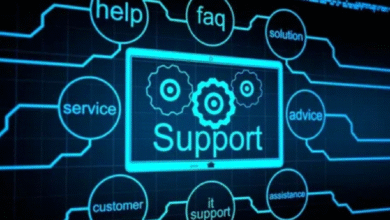Top Cloud Call Features Every Business Should Know in 2025

The old office phone is a museum piece. It sits on a desk. It is tied down by a coiled cord. Modern business cannot be tied down as it moves and adapts. It requires a nervous system built for today’s world.
This new nervous system is powered by advanced cloud call features. This technological leap redefines what a business phone can do.
By 2025, this redefinition will be complete. A company’s communication platform will be a measure of its agility. It will be a reflection of its customer focus. Let’s dissect the capabilities that will define business communication.
What is a Cloud-Based Phone System?
Before exploring the tools, we must understand the toolbox itself.
A cloud-based phone system removes the phone system from your server closet. It places it into a secure, professionally managed digital space. Your calls travel over the internet and are no longer dependent on physical copper wires. This untethers your entire communication structure from your physical office.
This freedom is the system’s foundational benefit.
Your team can now operate from anywhere. An agent can take a customer call from their home office. A salesperson can dial from a mobile app between meetings. A CEO can join a conference call from an airport lounge. The office phone number follows the person. It is not tied to the desk. This is a fundamental shift in operational design.
This shift delivers unmatched flexibility and cost control.
Call Routing: The Digital Traffic Controller
A flood of incoming calls without a plan is chaos. The system’s true intelligence lies in its ability to direct this traffic.
Call routing is the logic engine of your phone system. It is a digital traffic controller. It analyzes incoming calls. It sends them to the perfect destination based on a set of rules you create. This process happens instantly. The caller never knows the complex decisions being made. They just get help faster.
A well-designed routing strategy is the difference between frustration and satisfaction.
Modern platforms offer incredibly smart routing options.
- The 24/7 Receptionist
This is time-of-day routing. The system knows your operating hours. During the day, calls go to the main team. After 5 PM, they might go to a specific after-hours support line. On weekends, they can be directed to a detailed voicemail menu. Your business is always responsive.
- The Expert Connector
This is skills-based routing. The system can ask a caller, “Are you calling about a new order or a technical issue?” Based on the answer, it sends the call to a sales expert or a technical support specialist. It eliminates internal transfers. It connects problems directly to solutions.
- The Local Touch
This is geographic routing. A caller from New York is automatically connected to your East Coast sales team. A caller from California reaches the West Coast office. This creates a personalized, local feel, even for a national company.
These automated decisions create a highly efficient front line for your business.
Essential Capabilities for the Modern Command Center
Smart direction is the beginning. A truly powerful system provides a full arsenal of tools to enhance every conversation.
These capabilities turn a simple phone system into a business intelligence platform.
1. Transforming Voice into Data
Every call can be automatically transcribed into text. The spoken word becomes a searchable digital asset. You can instantly find a conversation about a specific product or issue. The system can also analyze the text for sentiment. It flags calls with frustrated language. This allows managers to review interactions and improve training.
2. Liberating Messages from the Handset
The blinking red light on a desk phone is an archaic way to manage messages. Modern systems send voicemails directly to your email. You receive an audio file and a text transcription. You can read or listen to messages on your laptop or smartphone. You can forward them to a colleague for faster resolution.
3. The All-in-One Communication Hub
Your voice system should not be an island. It should be the center of a Unified Communications (UCaaS) platform. This integrates voice, video conferencing, and team chat into one application. A team can move from a chat discussion to a group call to a video meeting seamlessly.
4. Conversations with Your Phone System
Interactive Voice Response (IVR) has evolved. Callers no longer have to navigate rigid “press 1, press 2” menus. They can speak naturally. The customer may say, I want to know about my order status and the system knows. It is able to give the information or transfer the call to the appropriate department.
These tools work in concert to build a formidable communication command center.
Protecting Your Connection: API Security in 2025
Your phone system’s power multiplies when it connects to other software. These connections are its digital bridges.
These bridges are called APIs (Application Programming Interfaces). They allow your cloud-based phone system to have a digital handshake with your CRM, your helpdesk, or your billing software. An incoming call can trigger a screen pop with the customer’s entire history. This is incredibly efficient. It also creates a new perimeter that must be defended.
The API Security in 2025 is paramount because it is an open door to your most sensitive customer data and business operations.
Demand these security proofs from any potential provider.
- Ask Who Holds the Keys: The system must use strong authentication protocols. This is the digital equivalent of a complex, unique key for every application that needs access.
- Inquire About Flood Defenses: Rate limiting is essential. It prevents a single bad actor or malfunctioning app from flooding your system with requests and causing a shutdown.
- Ensure the Conversation is Private: All the data transferred by the API should be encrypted. This encapsulates all the information in a shield, and it would be unreadable if it were intercepted.
- Demand Proof of Protection: Your provider must be audited frequently by an independent third party in terms of security. They must be in a position to give you certifications and reports to show that their defenses are good.
Building your communication platform on a secure foundation is not negotiable.
Your Launch Sequence for Cloud Communication
Making this transition is not just an IT project. It is a strategic business upgrade that requires a clear plan.
Follow this launch sequence for a successful deployment.
- Define the Mission. First, map out your objectives. How many people need access? Which features will have the biggest impact on your customer service? What is your budget? A clear mission guides every subsequent decision.
- Choose Your Technology Partner. Next, vet potential providers. Compare their features. Read reviews from companies like yours. Most importantly, use the security checklist above to grill them on their API defenses.
- Map the Transition. Work with your chosen partner to create a detailed migration plan. Schedule the transfer of your existing phone numbers to minimize disruption. Set a clear go-live date.
- Empower the Crew. Before and after the launch, train your team. Show them how to use the new tools. Get them excited about the new capabilities that will make their jobs easier.
- Calibrate for Peak Performance. After launch, use the system’s built-in analytics. Watch your call data. Are wait times decreasing? Are calls being routed correctly? Use this information to tune your setup and increase productivity.
By following this intentional process, your new system performs as promised.
Expanding the Mindset: Essential Business Reading
The effectiveness of great tools is limited to the thinking that goes into them. Leaders should also invest in their strategic knowledge to actually take advantage of this technology.
Continuous learning fuels intelligent growth. These selections from the world of best business books can sharpen your approach.
- “The Lean Startup” by Eric Ries: This book’s philosophy of building, measuring, and learning is perfect for a technology rollout. Use its principles to test your call routing rules and optimize your setup based on real data.
- “Good to Great” by Jim Collins: Collins is well known for saying that technology is a momentum accelerator and not a momentum creator. It is an important lesson. A great phone system will make a great business better. It will not fix a broken strategy.
- “Never Split the Difference” by Chris Voss: Your new system will handle countless conversations. This book provides elite-level negotiation and communication tactics to ensure the human side of those conversations is as effective as the technology enabling them.
Pairing powerful tools with powerful ideas is the key to market leadership.
Conclusion
The era of the stationary, single-purpose phone is over. The communication platform of tomorrow is a dynamic, intelligent, and secure asset. It is the core of a resilient and responsive organization.
The tools for this transformation are already here. Features that direct inquiries, convert speech to data, and unify your team are now accessible to businesses of all sizes. The crucial step is protecting these new capabilities. Now is the time to assess your current limitations. It is time to embrace the future of business conversation.
The question is no longer if you should make the change. The question is how fast you can lead it.



